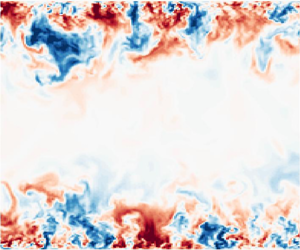Article contents
An isolated logarithmic layer
Published online by Cambridge University Press: 14 April 2021
Abstract

To isolate the multiscale dynamics of the logarithmic layer of wall-bounded turbulent flows, a novel numerical experiment is conducted in which the mean tangential Reynolds stress is eliminated except in a subregion corresponding to the typical location of the logarithmic layer in channels. Various statistical comparisons against channel flow databases show that, despite some differences, this modified flow system reproduces the kinematics and dynamics of natural logarithmic layers well, even in the absence of a buffer and an outer zone. This supports the previous idea that the logarithmic layer has its own autonomous dynamics. In particular, the results suggest that the mean velocity gradient and the wall-parallel scale of the largest eddies are determined by the height of the tallest momentum-transferring motions, which implies that the very large-scale motions of wall-bounded flows are not an intrinsic part of the logarithmic-layer dynamics. Using a similar set-up, an isolated layer with a constant total stress, which represents the logarithmic layer without a driving force, is simulated and examined.
Information
- Type
- JFM Papers
- Information
- Copyright
- © The Author(s), 2021. Published by Cambridge University Press
References
REFERENCES
- 9
- Cited by


